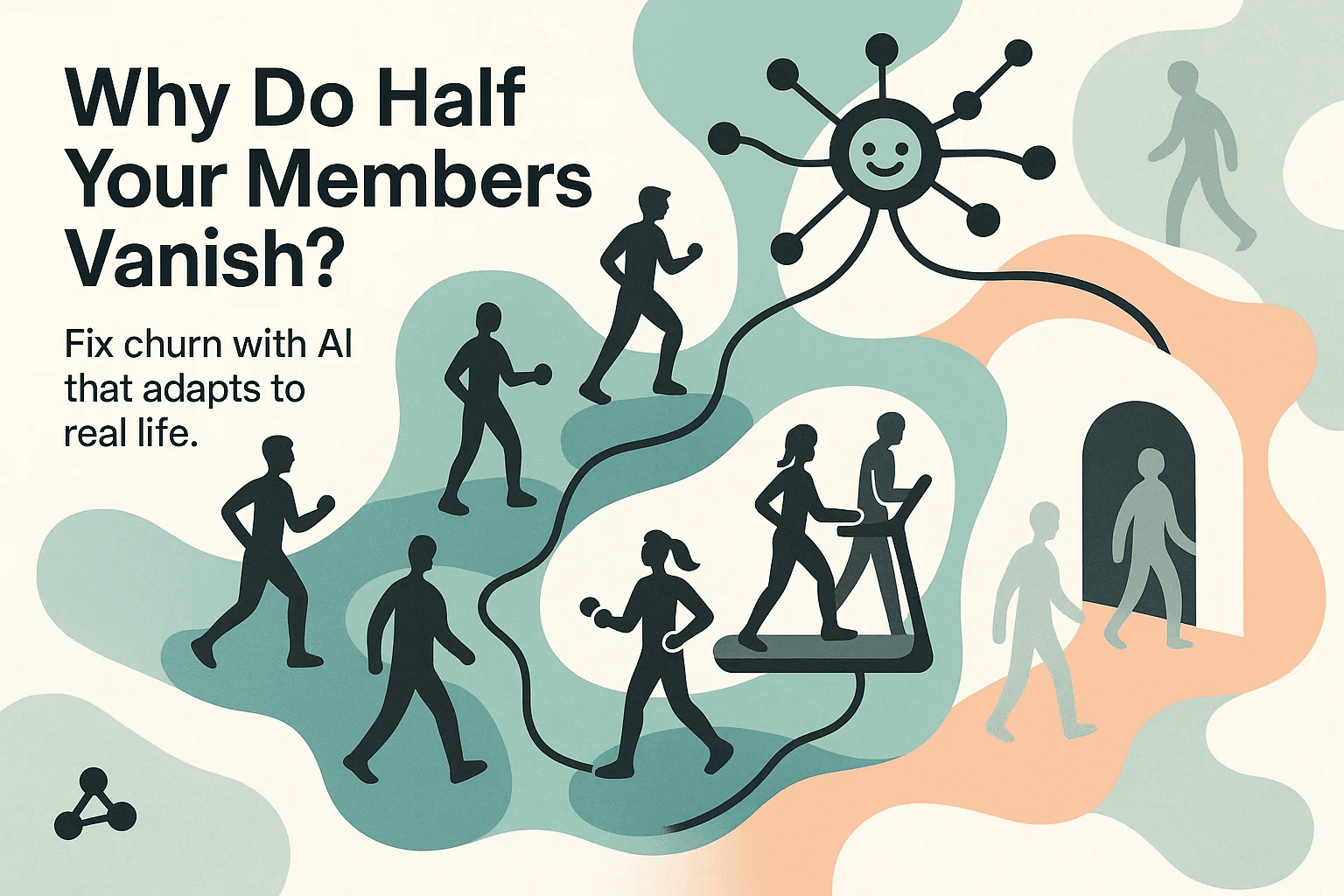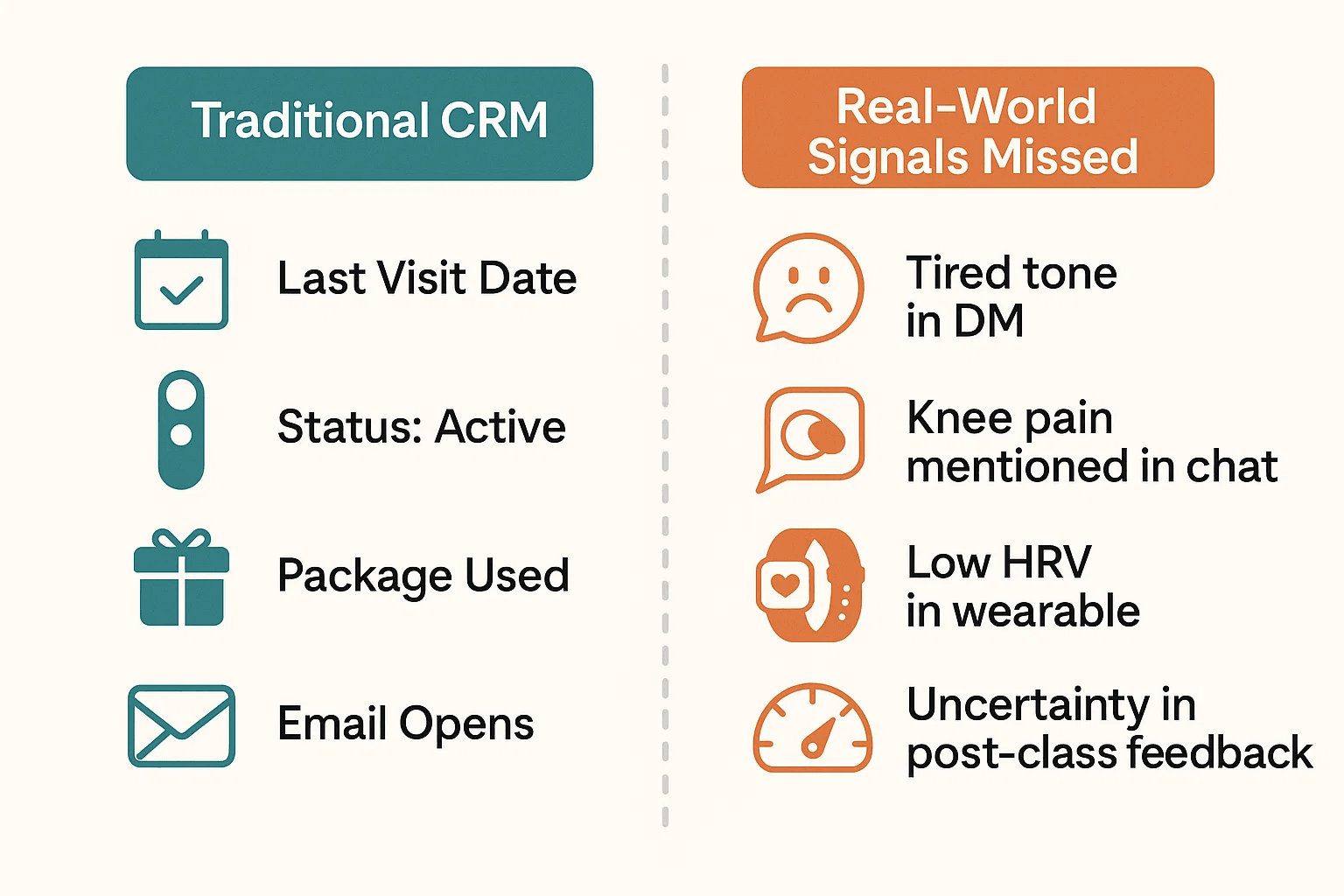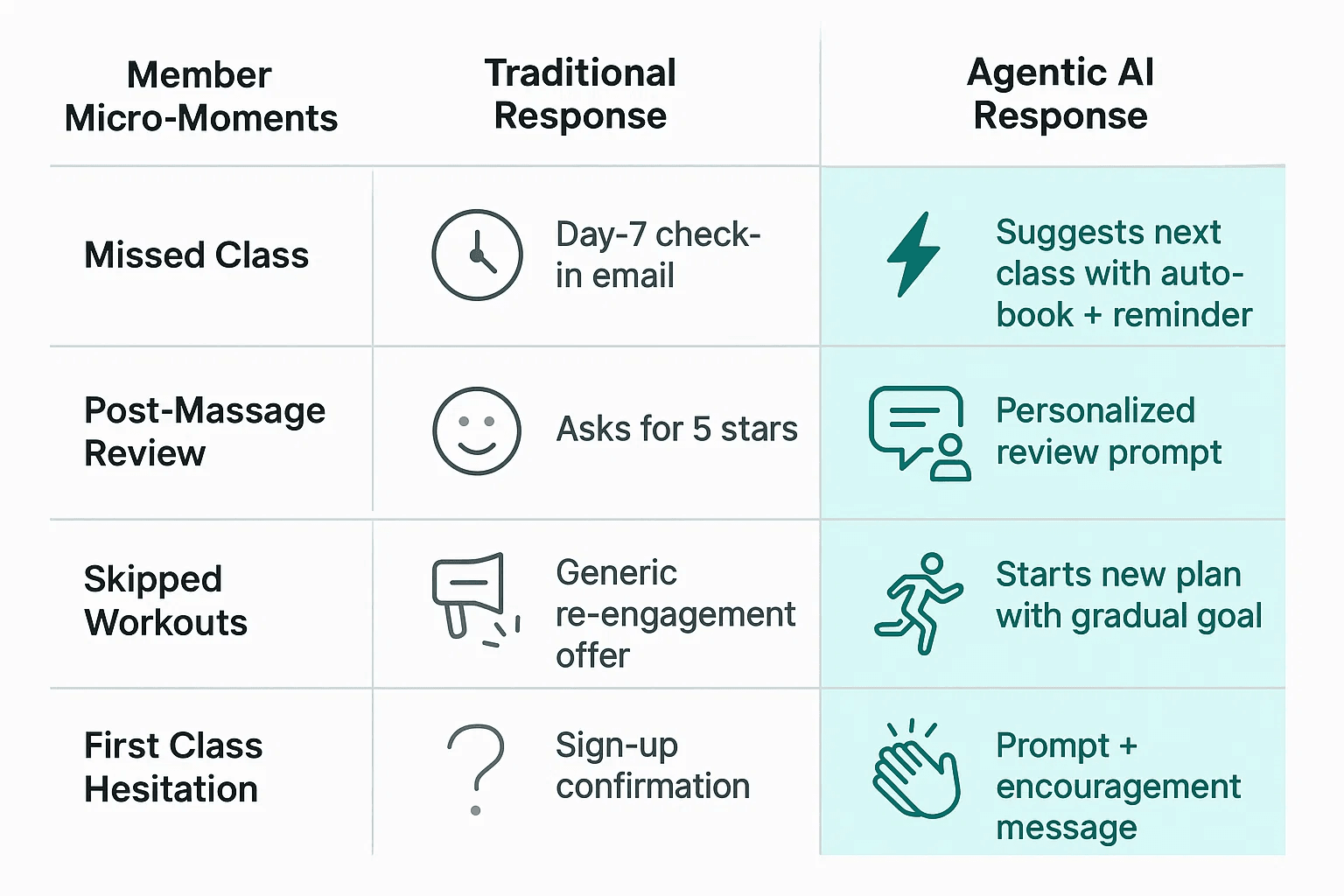Agentic AI in Gyms and Spa Chains: Fixing Customer Journey Leaks

The wellness business looks healthy on paper. Global fitness revenue has topped $240 billion, and spa chains keep setting new sales records. Yet hidden behind those big numbers is a churn problem large enough to erase most of the gains. A typical gym loses around 40 percent of its members every year, and half of the new joiners disappear within six months. Spa programs based on prepaid packages or monthly subscriptions show the same drop-off.
Why does the industry leak so badly? Because the tools still treat every customer as a line in a spreadsheet—an “active member” or a “lapsed lead”—instead of a human whose motivation, stress level, and schedule change every week. That critical context is qualitative: WhatsApp chats about a sore shoulder, voice notes asking about class intensity, or a Google review that hints at anxiety about crowded locker rooms. Traditional CRMs and booking systems never capture that "nuance".
What Agentic AI actually means
Agentic AI refers to autonomous software agents that decide, act, and learn on the fly. They are not rule–based bots or timed email drips. A true agentic system:
Reads every inbound signal—chat text, call transcripts, wearable data—and tags it for mood, urgency, and intent.
Chooses the next best action without waiting for a human workflow: send a motivational push, suggest a quieter class, escalate to a live trainer, or simply listen.
Stores the outcome in a single Conversation Graph (Zigment’s proprietary customer journey data structure) so future decisions get smarter.
That loop repeats thousands of times a day, across every touchpoint. The result is a customer journey that adapts as quickly as a member’s life does.
Where the current funnel breaks
Trial to Commit
The “free-trial week” is supposed to be a low-friction door into membership, yet half of all prospects vanish before day 7. The problem isn’t price; it’s friction layered in small moments. A visitor may hesitate because they aren’t sure if the evening Zumba class matches their fitness level, or they need to know whether the spa’s hydrotherapy pools are gender-separated. If these questions surface at 9 p.m. and the only response channel is an unanswered web form, the moment of intent dies. By the time a staff member calls back the next morning, that motivation has been replaced by a new to-do list and a dozen distractions. The funnel breaks not from a single gap, but from hundreds of micro-delays that simmer beneath the KPI dashboards.

On-Ramp Drop-Off
Gyms celebrate sign-ups as “wins,” but an unused membership is merely churn written on a time delay. Behavioural science is clear: the first seven days after commitment set the tone for the entire relationship. If a new member misses the first booked class—maybe a surprise work call or school pickup ran late—guilt and embarrassment arrive before the marketing automation’s day-7 check-in. Traditional workflows can’t sense that missed scan at the turnstile or hear the discouragement in a DM that says, “Maybe next week.” The pipeline looks healthy in the CRM, yet momentum has already bled out.
Plateau & Churn
Beyond month three, progress naturally slows as the “newbie gains” phase ends. Motivation dips, and attendance falls into an uneven pattern. Conventional retention tactics are blasts: a generic “We miss you!” e-mail or a half-price renewal offer. They ignore what is actually happening in the member’s life: perhaps work travel has spiked, or energy levels have dipped because of seasonal allergies. Without a personalised nudge at exactly the right time, the member drifts from three visits per week to one, then to none, and the CRM silently flips a status from “active” to “at risk” long after they have mentally churned.
Upsell Stagnation
Spas rely on high-margin add-ons—aromatherapy, LED facials, salt caves—to raise average ticket size. The ideal moment to pitch is when a guest finishes a treatment and feels endorphins spike. Unfortunately, most spas wait for the nightly batch file to sync POS data with the e-mail platform. The upsell arrives 36 hours later, when the good mood has faded and the message looks like boilerplate marketing. That disconnect between peak emotional state and actual outreach causes the upsell funnel to sputter even when capacity is available.
How Agentic AI Patches Every Leak — End to End
Instant omnichannel response
An agentic system acts like a top-performing front-desk manager who never sleeps. A website visitor types, “Is tonight’s Pilates class beginner-friendly?” and the AI answers in under three seconds, books the slot, and sends a WhatsApp confirmation before the prospect can open a competing tab. Industry data shows conversion odds plummet by 80 % when replies exceed ten minutes; collapsing that to real time stops motivation decay before it starts.
Personalised nudges built on real sentiment
Traditional campaigns fire on dates; agentic nudges fire on feelings. If the Conversation Graph detects “tired” sentiment after a tough session, the agent suggests a gentle recovery class and a complimentary sauna. When wearable data shows skipped workouts, it offers a 20-minute HIIT alternative instead of guilt-trip e-mails. Micro-interventions like these raised six-month retention nine points in early pilots.

Dynamic retention journeys
Static workflows tag members “at risk” only after weeks of absence. Agentic AI recalculates risk daily: miss two visits, and the agent cross-checks the calendar, sees a business trip, and gifts a hotel-gym pass; mention knee pain in chat, and it routes you to a physio video consult. The system turns potential churn events into loyalty moments without manual triage.
Context-aware upsell timing
Upsells win when they feel like help, not a sales push. The agent listens for peak-emotion cues: “Best massage ever 😍” in a post-treatment survey triggers a limited-time salt-room offer while satisfaction is high, boosting add-on take-rate nearly 20 % above last year’s average.
Personal AI concierge for onboarding and retention
From day one, a digital concierge welcomes new members, maps goals, books first classes, and delivers a QR pass—erasing onboarding friction. It then stays on as a smart companion: spots a dip in visits, notes a week of late-night Zoom calls, and suggests a 6 a.m. express spin with a pre-booked locker and smoothie voucher; sees better sleep scores on a wearable and recommends leveling up to HIIT or adding a sports massage. Anniversary highlight reels (“137 workouts, 52,000 calories—enough to lift a Boeing 737”) gamify progress, and early rollouts have lifted NPS by 12 points and premium add-on sales by 15 %, proving that when members feel seen, they stay—and spend.
Benchmarks to aim for
Benchmarks to aim for
Stage | Industry baseline | Agentic AI target |
Trial-to-join conversion | 10 % | 20 %+ |
Six-month retention | 50 % | 70 %+ |
Average monthly revenue per member | $72 | $85–95 |
Service upsell take-rate | 12 % | 25 %+ |
The goals look aggressive but align with numbers reported by AI-forward fitness chains. The global market for AI in wellness is forecast to reach midsize-tech-sector scale within a decade, and operators that move early capture the learning curve.
Implementing Agentic AI Without Breaking Member Trust
Start with a Single Journey
Choose the onboarding week; its metrics are unambiguous and its data is easy to collect. Deploy an AI agent that checks attendance daily and sends context-sensitive nudges—“Haven’t seen you yet, your complimentary PT session is still reserved!”—via the member’s preferred channel. Track attendance and first-month retention before widening scope. Stakeholders see immediate ROI, making further rollout a budget conversation rather than a philosophical debate.
Feed Clean, High-Resolution Data
Agentic AI is only as good as its inputs. Export class schedules, attendance history, POS transactions, trainer notes, review text, and—where permitted—wearable stats. Tag fields consistently: “Pilates-Beginner” should never appear as “Pilates_L1” in another table. The Conversation Graph relies on semantic coherence; clean keys mean faster learning and fewer hallucinations.
Set Guardrails the Team Understands
Autonomy thrives when boundaries are clear. Define acceptable tone (“friendly, concise, no sarcasm”), escalation rules (“if pain or injury keywords, alert a human in 60 seconds”), and offer limits (“never discount PT packages below 15 percent without manual approval”). Encode them as policies so trainers and managers trust the agent rather than view it as a rogue marketer.
Measure Behaviour, Not Vanity Metrics
Open-rates and clicks matter less than active-days-per-member, sentiment-weighted NPS, and revenue tied to agent-initiated chats. Dashboards should surface the before-and-after delta for each micro-journey—trial conversion, week-four attendance, upsell acceptance—so improvements are concrete and defensible.
Iterate Weekly for Compound Gains
Agentic models learn fast, but only if their operators prune dead weight. Review journey analytics every week: promote prompts that drive action, retire those that stall, and refresh examples in the agent’s memory. Because the cost of redeploying a model version is near zero, continuous iteration compounds retention and revenue lift quarter over quarter.
Objections answered
“Members will find AI impersonal.”
Not if the agent is useful. Personalisation beats small talk when the system remembers your knee injury and swaps squats for leg press without you asking.
“Staff will feel replaced.”
Think augmentation, not substitution. Trainers spend less time on scheduling and more on coaching; therapists focus on service quality while the agent handles re-booking.
“What about data privacy?”
SOC 2 and HIPAA controls are table stakes. Best-in-class platforms route personal details through tokenised vaults and retain no conversational context once the task ends.
Where Zigment fits in
Zigment is an Agentic AI Customer-Journey Platform purpose-built for conversation-driven businesses. Our omnichannel agents engage members on web chat, WhatsApp, SMS, voice, and social DMs in under three seconds. A drag-and-drop workflow engine reacts to any trigger—from an inbound lead to an outbound cold list—while our Conversation Graph records every click, message, sentiment, and decision. Gyms and spa chains using Zigment have trimmed manual follow-up time by 90 percent and lifted trial-to-join conversions by double-digit percentages within the first month. With SOC 2 Type II, ISO 27001, HIPAA, and GDPR baked in, you can roll out in under four weeks and watch the leaks disappear—without adding headcount.
Agentic AI is no longer sci-fi; it is a practical fix for the weakest parts of your customer journey. Start small, measure everything, and let autonomous intelligence handle the repetition so your human team can focus on motivation and care. Your members—and your balance sheet—will feel the difference.
